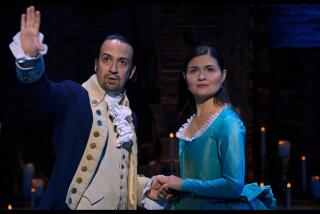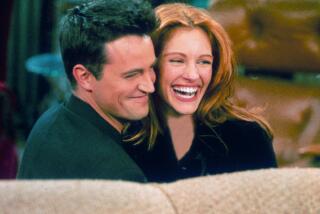A Second Look: ‘America Lost and Found: The BBS Story’ collection captures New Hollywood’s iconic, weird twists
The story of American cinema’s last official golden age — the late ‘60s and early ‘70s groundswell known as the New Hollywood — has been told and retold so many times and with such gilded nostalgia that it is by now, at least in part, a sentimental myth.
It’s easy to understand the lasting appeal of the era. The movies seemed more connected to their moment, and that moment offered so much to connect with: the countercultural thrills of sex, drugs and rock ‘n’ roll; the specter of war and the tumult of radical politics; the explosion of world, experimental and underground cinema, and the rise of various European new waves.
What often gets lost in the hagiographic process are the particularities of the films. One of the great attractions of “America Lost and Found: The BBS Story,” a new seven-film DVD boxed set from the Criterion Collection, is that several of the period’s most iconic artifacts are accounted for along with a few of its weirdest oddities. The set, released in Blu-ray high-definition this week (the standard-definition edition is due out Dec. 14), refracts the legend of the American New Wave through the history of BBS, a short-lived but influential production company formed by Bob Rafelson, Bert Schneider and Steve Blauner.
This particular New Hollywood subplot begins with, of all things, the Monkees, the telegenic proto-boy-band creation of Rafelson and Schneider. Conceived after the cancellation of the pop idols’ NBC sitcom, “Head” (1968) was the feature-length elaboration and deconstruction of the Monkees project (“a manufactured image,” they chant, “with no philosophies”), directed by Rafelson, who co-wrote the script with Jack Nicholson, then an up-and-coming actor and the author of the Roger Corman LSD cult film, “The Trip” (1967).
A freewheeling hall-of-mirrors satire, “Head” cross-breeds genres, steals visual tricks from the avant-garde grab bag, riffs on the then-fashionable media-futurist theories of Marshall McLuhan and even tastelessly tosses in some Vietnam War commentary (newsreel footage of an execution). The film’s freaky psychedelia bombed with teeny-boppers and hipsters — as if dramatizing its own commercial suicide, it begins (and ends) with the Monkees, one by one, hurling themselves off a bridge.
But the next BBS production secured the company’s financial future. Rafelson and Schneider had agreed to fund “Easy Rider” (1969), the directing debut by the hippest of Method actors, Dennis Hopper, which would pair Hopper and his buddy Peter Fonda as road-tripping bikers who, per the film’s tag line, “went looking for America and couldn’t find it anywhere.”
A smash hit and the peak of Hollywood’s flirtation with counterculture chic (not to mention the defining document of hippie self-mythology), “Easy Rider” landed BBS a six-picture deal at Columbia Pictures. Five of the resulting films are included in the Criterion set: two Rafelson-directed dramas, “Five Easy Pieces” (1970) and “The King of Marvin Gardens” (1972); Peter Bogdanovich’s “The Last Picture Show” (1971), the most Old Hollywood of New Hollywood movies; and a pair of directing debuts, Nicholson’s queasy campus comedy, “Drive, He Said” (1971), and Henry Jaglom’s “A Safe Place” (1971), a heavily improvised fantasy psychodrama with Tuesday Weld, Nicholson and Orson Welles. (Peter Davis’ anti-Vietnam War documentary, “Hearts and Minds,” eventually released through Warner Bros., is the one missing title.)
Many key figures of the New Hollywood circulated in the BBS orbit, among them László Kovacs, the Hungarian-born cinematographer with a soulful eye for American landscapes, and the actors Bruce Dern and Karen Black. But the undisputed star of the BBS story is Nicholson: “Head” co-writer, “Easy Rider” scene stealer, the ambiguously charismatic leading man of “Five Easy Pieces” and, demonstrating his range, the buttoned-up sidekick (to Dern, who in turn channeled Nicholson) in “The King of Marvin Gardens.”
Rafelson’s anticlimactic directing career is another intriguing thread here — a few of his later works have been unfairly dismissed (“Stay Hungry,” for one), but he never again approached the heights of his two minor-key early-’70s character studies. Nicholson’s pianist turned oil rigger in “Five Easy Pieces” personifies an ambivalence that defined the American movies of the era. “The King of Marvin Gardens,” the story of two estranged brothers and the sharp collision of dreams and reality, finds a perfect setting, at once concrete and metaphoric, for its downbeat poetics: a grim, off-season, pre-makeover Atlantic City.
Both are terminally sad films, which is perhaps to say that both are quintessential products of their time. The New Hollywood might was sparked by a revolutionary moment, but it played out over the course of a post-1968 hangover; its house specialty, for better and for worse, was the romance of failure.
More to Read
Only good movies
Get the Indie Focus newsletter, Mark Olsen's weekly guide to the world of cinema.
You may occasionally receive promotional content from the Los Angeles Times.










